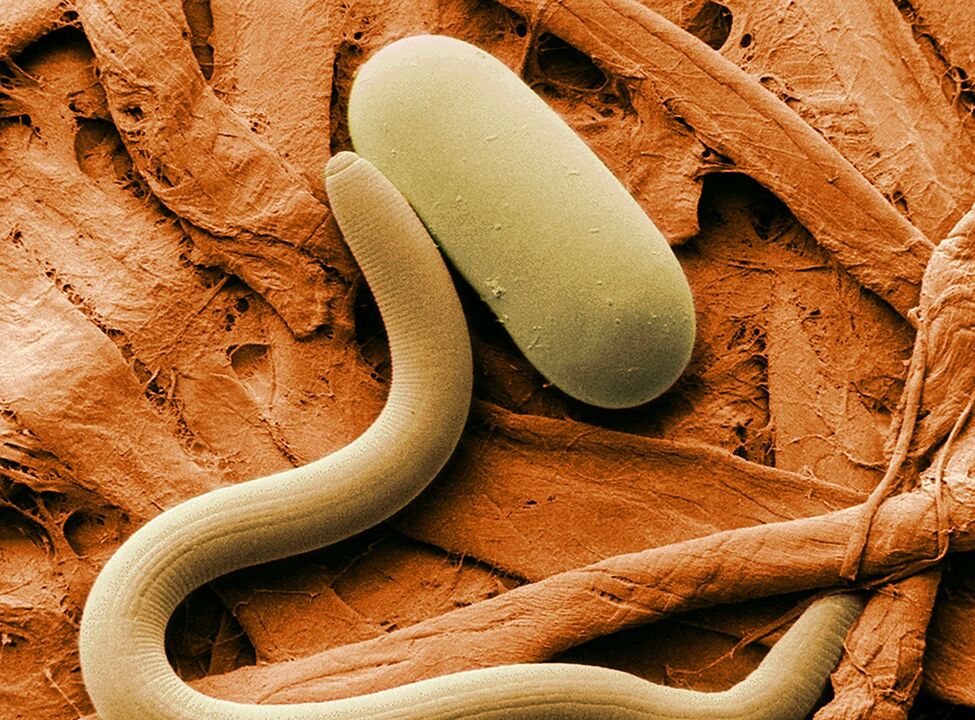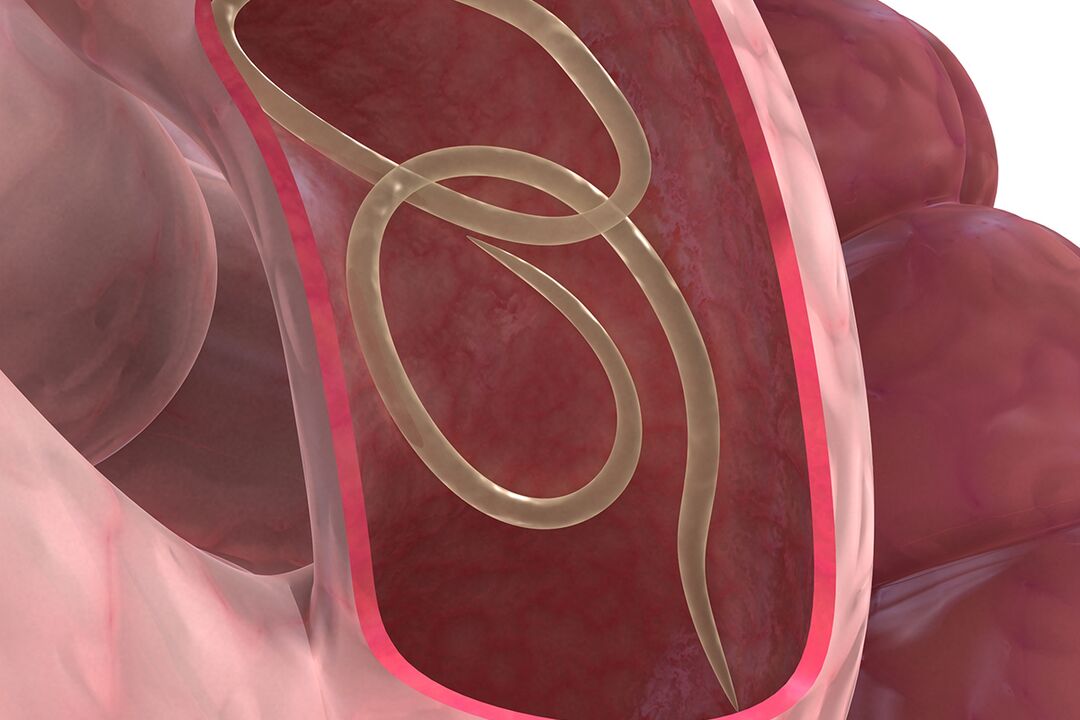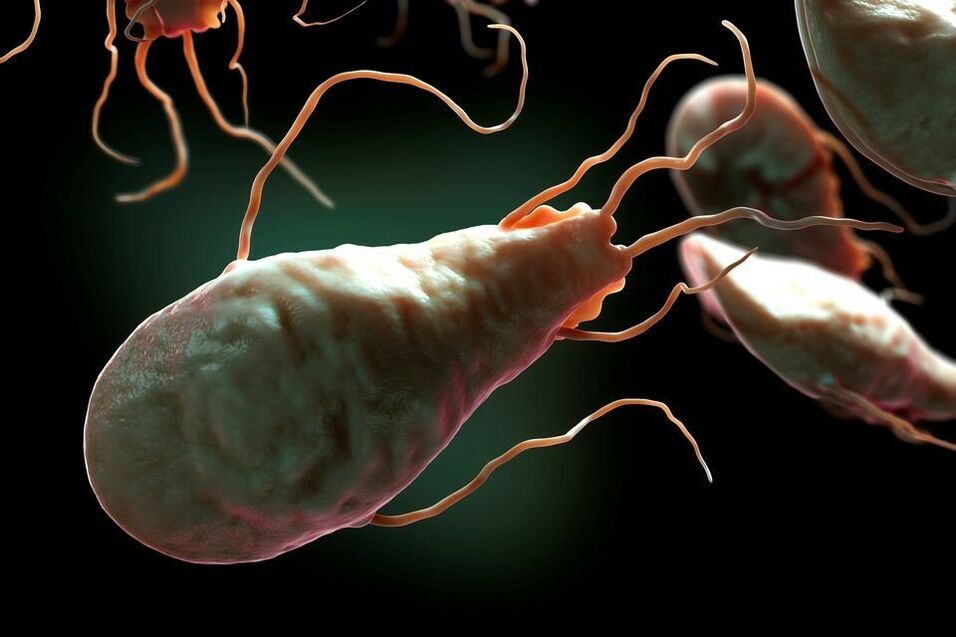Worms are representatives of the lower worms that live in the human body. The disease associated with the infection of different types of worms is called helminthiasis. This disease is not uncommon and occurs in certain segments of the population. Children are prone to fungal infections, hunters - trichinella, fishermen and lovers of Japanese cuisine (in the form of raw fish sushi) suffer from difhyllobothriasis. Paradoxically, many diseases can occur in the human body due to helminthiasis infection. To date, the theory of the relationship between cancer and parasitic infections is one of the most relevant. In the presence of helminthiasis, symptoms do not always appear, and if, nevertheless, patients with the disease experience discomfort and discomfort, it is perceived as a sign of other illnesses. The patient has been treated for years for inflammation of the pancreas, gastritis or colon, not knowing that the cause of his disease is helminthiasis.
How the infection occurs
Worms cause a lot of trouble to humans

Infection with helminth samples is as follows:
- Through unwashed hands
- In contact with soil
- after insect bites
- Because of dirty hands
- When consuming raw meat and fish
- After eating unwashed fruits and vegetables
- After contact with animals
- After contact with infected people
The mature eggs of parasites are found in soil, water, food (raw and poorly cooked meat or fish). Rare cases of the disease occur due to insect bites. The mechanism of helminthiasis infection is oral-fecal. Man swallows the eggs of parasites with food and water. Contact household infections also occur. These occur when the hands have not been washed thoroughly after contact with the ground or sand.
Unwashed vegetables and berries growing in the ground are also sources of infection for worms. Children playing in the yard and pets are at risk of being infected by worms. Pets roaming the streets can bring helminth eggs into the house. Flies and other insects can easily transfer helminth eggs while sitting on food after coming into contact with animal feces. Surprisingly, human-to-human transmission is also possible. This is how the female needle worm crawls out of the gut and can lay eggs directly on its underwear, causing severe itching. A person who has combed the itchy area may come into contact with other toiletries and household items. These items fall into the hands of other family members, after which they become infected.
Waterborne infection is also possible. Many parasitic eggs easily fall into open water bodies and wells. Consumption of unboiled well water is extremely dangerous.
Types of helminthiasis
Helminthiases differ from the way they enter the human body:
- Biohelminths
- Geohelminths
- infectious
Biohelmed samples are transmitted to humans through contact with animals. Geohelminth can become infected through the soil. An infectious disease results from contact with an infected person. The disease manifests itself differently depending on the mode of infection, the number of worms, and the degree of adaptation to the human organ.
Stages of helminthiasis

The most devastating effect on the body is not the adults but their larvae. Adults have already chosen a homey place in the human body, the larvae passing through the organs and leaving their lesions. The most common habitat for parasites is the gastrointestinal tract. Different types of parasites prefer different habitats. Thus, tapeworms settle in the small intestine and needles in the colon and lower parts of the small intestine. According to the habitat of the parasites, helminthiases are:
- translucent
- fabric
The translucent is found in the lumen of the genitals and the tissue in the tissues. Depending on the growth, the parasites can change their habitat and enter the tissues from a translucent form. Helminthiasis develops in two stages:
- acute
- Chronic
The acute stage lasts from one week to a month and the chronic stage lasts until recovery. The acute stage begins with the entry of the egg and continues with the maturation and growth of the parasite. The disease manifests itself in allergic reactions to a foreign body. In the chronic phase of the disease, various reactions in the body occur. During this period, the parasite moves in the body in search of shelter. The disease is accompanied by disturbances in the functioning of the organs and systems of the human body. When integrated into the human body's immune system, parasites consume the substances needed for their growth and development. This leads to metabolic disorders, gastrointestinal disorders, difficulties in absorbing vitamins and minerals.
In addition to this damage, parasites push their waste products into the human body, poisoning the body, leading to intestinal disorders, reduced immunity, and the development of bacterial infections. Parasites contribute to the risk of developing cancer. This is due to the negative effect on the immune system and the stimulation of the cell division process. The patient is often examined by many professionals who find a lot of disease in it. And in this case, only one doctor, one parasitologist, can replace all the specialists.
Classification of helminth samples

tapeworms are quite common
Types of worms that occur in humans:
- flatworms
- earthworms
Flatworms include:
- Trematodes (opisthorchis, schistosomes, paragonim)
- Cestodes (broad tapeworm, tapeworm, echinococcus, alveococcus)
- Worms or nematodes:
- Pinworm
- Ascaris
- hookworm
- Trichinella
Such a classification of helminth samples is described in the medical literature. A successful description of such a problem, such as helminthiasis, requires a thorough description of the structure and life cycle of the parasites.
Trematodes
The other name for the trematodes is métely. These parasites are flat, leaf-shaped or lanceolate with two suction heads. One suction is in the mouth, the second, which is used for fixation, is in the peritoneum. All representatives of the vultures enter the organization through an intermediate host. These parasites are mostly hermaphrodites.
Opisthorchises
This wart is a worm up to 1, 3 cm long with two suction cups. Opisthorchis is a hermaphrodite that lives in humans in the liver, gallbladder, pancreas, and some predators (foxes, dogs, cats). Eggs of opisthorchiasis are excreted in the feces of the human or animal body. When they enter the reservoir, these eggs are swallowed by the freshwater molluscs in which the larvae hatch and develop. The process of development and maturation of larvae takes two months. The larvae then climb out of the mollusk and penetrate under the skin to the carp. After six weeks, the larvae become full-fledged, adult parasites. Opisthorchis enters the body of an animal or person after eating an infected fish. This worm can live in a living organism for up to 20 years. Symptoms of opisthorchiasis:
- Allergy
- Weakness
- Headache
- Dizziness
- Depression
- Black out
Damage to the body caused by opisthorchiasis:
- Poisoning by parasite waste products
- Damage to liver tissue
- Damage to the gallbladder
- Violation of bile outflow
- Inflammation of the pancreas
- Secretory dysfunctions
- Decreased gastric motility
- Thickening of the walls of some organs, resulting in the development of tumors.
The chronic course of the disease is characterized by:
- Difficulty after eating
- Pain
- What number
- Nausea
Habitats of opisthorchis in fish-rich rivers:
- Kame
- Dnipro
- Neman Delta
Prevention of infection: To avoid infection with opisthorchiasis, do not eat raw fish. The larvae are killed during the heat treatment of the products. Dried fish can only be eaten if it has been previously salted. In addition, the larvae die if the fish is frozen for a long time.
Schistosomes

These parasites are of different sexes, appearing as needles 0, 4-2, 6 cm long, females are longer than males and larger, producing 3, 000 eggs per day. The mode of reproduction, as in previous parasite species, occurs through freshwater molluscs. The larvae enter the human body through the skin, the mucous membrane, while swimming in a freshwater reservoir. It can also enter the body of a person who accidentally swallows water while swimming. One day after penetration, the larva becomes an adult and enters the peripheral veins through which it enters the lungs and venous vessels. There the schistosome reaches sexual maturity.
Schistosoma lays eggs in the intestines, mucous membranes, and bladder. The eggs are then excreted in the human body in urine or feces and begin the path of development again. Schistosoma has been in the human body for decades, causing damage and infecting new individuals. The problems that occur during schistosome infection in the human body are caused not by adults but by their eggs. Only half of the eggs are excreted from the body, the rest accumulates in the organs. The eggs of this parasite have spikes that damage the internal organs of man, often ulcers in the infected. Patients with schistosomiasis experience the following symptoms:
- Appetite disorder
- Anemia
- Enlarged liver
- Changed spleen
- Decreased intestinal peristalsis
- Abdominal pain
- constipation
- diarrhea
- Weight loss
- Intestinal bleeding
- Pain while urinating
- allergies
- Weakness
When the urogenital system is infected, patients experience:
- Menstrual disorders and miscarriages in women
- Impotence and deficient ejaculation in men
When the egg enters the central nervous system:
- Acute cerebral schistosomiasis
- Chronic brain damage
- Fatal outcome
There is a delay in the growth and development of infected children and a decrease in their school performance. Prevention of the disease includes avoiding swimming and walking barefoot in tropical waters.
Paragonim

Paragonim is a 1 cm long, ovoid body with red spines. This parasite multiplies in the lungs of animals and enters the human body by consuming cancers, freshwater crayfish. The parasite infects the respiratory system. Patients with paragonimiasis are characterized by allergic reactions and decreased immunity. Symptoms:
- Temperature rise
- Cough
- Emptying sputum from the lungs when coughing
- Shortness of breath
- In severe cases, blood and parasitic eggs are found in the sputum.
- Breathing breathing is clearly audible in the patient's lungs.
- Prevention: rule out the use of raw crayfish and crabs.
Cestodes
Representatives of cestodes are tapeworms of different lengths. Some parasites reach enormous sizes. These parasites have suckers, hooks, or suction holes on their heads. These adaptations are needed for the parasites to adhere to the intestinal wall. Cestodes affect the entire human body, and are most dangerous for children who develop anemia quickly.
Echinococcus
These parasites reach 5 cm in length and are pathogens of Echinococcus disease. A multi-chamber representative of these types of worms is the causative agent of a disease such as alveococcosis. The disease is spread by cattle and domestic animals. In the care of these animals, parasite eggs fall from their fur into the hands of humans. Once in the human gut, the parasites bite into the mucous membranes. As the parasite reaches, 4 sections appear, the last of which is filled with eggs. These classes become detached and scattered throughout the body, infecting it. The fourth stage scatter the eggs throughout the body.
For example, an infected organ in a patient enlarges the liver. Suppuration may occur. An enlarged organ can even break through the abdominal cavity. This can lead to severe sepsis and even death in the body. Symptoms:
- Weakness
- Dizziness
- Allergic reactions to the waste products of parasites.
Echinococcus affects:
- Brain
- Spinal cord
- Eyes
- thyroid
- Liver
- Lungs
- bee
This parasite can trigger the development of tumors, including malignancies. The most unpleasant thing is that the treatment of this disease is only possible through surgery. Prevention: personal hygiene in contact with animals.
Nematodes
These elongated, round, or cylindrical worms most commonly parasitize the bodies of children. These roundworms include dumplings, spindleworms, and hookworms.
Pinworms

These are little white worms. The length of the female is 1 cm, the male is 0, 5 cm. These parasites have a pointed tail, which is why they were called dumplings. The habitat of pinworms is the human gut. At the front end of the parasite is a suction that allows the fungus to drill the intestines, and the sharp end hangs into the lumen to damage the walls. This disease is called enterobiasis. Contaminated hands can infect a person. Preschool children attending kindergarten have an illness. One of the symptoms of a fungal infection is itching around the anus. More often, the itching is felt at night when the female lays eggs while releasing a special substance. Symptoms:
- Itchy
- Diarrhea
- Abdominal pain
- Headache
- Anorexia
- Prevention
- hand washing
Wormwood
These worms are the biggest. The length of the female is not more than 0. 5 m. The female lays 200, 000 eggs a year, regardless of the male. The mechanism of infection is faecal-oral. Ascaris eggs, along with unwashed vegetables and fruits, get into the human body with dirty hands. The larvae that enter the gut are excreted from the shell and penetrate the intestinal wall as it migrates through the intestinal veins to the liver, through the hepatic veins to the heart, through the pulmonary arteries to the bronchi, and then into the intestinal tract. trachea and mouth. Some of the larvae die in the open air, the others are swallowed backwards. Symptoms:
- Nausea
- What number
- Jaundice
- pancreatitis
- Common acute respiratory infections
- Bronchitis
- Pneumonia
Prevention:
- hand washing
- Washing vegetables and fruits
- Personal hygiene
- Protect your food from flies, cockroaches and other vendors.
In conclusion, the cause of the disease is not always the bacteria and viruses that have entered the body. Parasites can cause serious damage to human health. In case of unclear symptoms, it is not necessary to exclude the parasite from entering the body, the patient should consult a parasitologist.



























